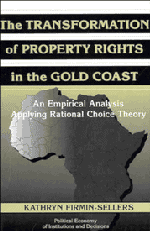 The Transformation of Property Rights in the Gold Coast
The Transformation of Property Rights in the Gold Coast Book contents
- Frontmatter
- Contents
- Series editor' preface
- Preface
- Acknowledgments
- Chapter 1 Introduction
- PART I THE INSTITUTIONS OF THE COLONIAL STATE
- PART II THE REINVENTION OF TRADITION: THE EVOLUTION OF PROPERTY RIGHTS UNDER INDIRECT RULE
- PART III THE TRANSITION TO INDEPENDENT GOVERNMENT
- Chapter 5 Redefining the institutions of central government: The writing of the Coussey Constitution
- Chapter 6 The return to the traditional state
- Chapter 7 Conclusion
- Notes
- Bibliography
- Index
Chapter 5 - Redefining the institutions of central government: The writing of the Coussey Constitution
Published online by Cambridge University Press: 08 January 2010
- Frontmatter
- Contents
- Series editor' preface
- Preface
- Acknowledgments
- Chapter 1 Introduction
- PART I THE INSTITUTIONS OF THE COLONIAL STATE
- PART II THE REINVENTION OF TRADITION: THE EVOLUTION OF PROPERTY RIGHTS UNDER INDIRECT RULE
- PART III THE TRANSITION TO INDEPENDENT GOVERNMENT
- Chapter 5 Redefining the institutions of central government: The writing of the Coussey Constitution
- Chapter 6 The return to the traditional state
- Chapter 7 Conclusion
- Notes
- Bibliography
- Index
Summary
The Accra riots of 1948 heralded a period of rapid and profound political change in the Gold Coast Colony. The changes would ultimately culminate in Gold Coast independence in 1957. In this chapter, I analyze the starting point for this transformation: the drafting and implementation of the Gold Coast constitution of 1950. Briefly, I argue that, during the original episode of constitutional creation, the British colonial government adopted procedures that encouraged Gold Coast elites to use the constitution to pursue narrow, redistributive gains – including the redefinition of rights to land. The British adopted procedures that encouraged elites to concentrate authority, deliberately forgoing potential safeguards against arbitrary, authoritarian rule.
I develop this thesis in three stages. In the first, I identify the actors who participated in the design of the 1950 constitution. How did the Gold Coast elite mobilize themselves at the national level, who challenged them, and how did the British respond? In the second and third, I examine the successive stages of constitutional creation. At each juncture, I explore the interaction between British control over procedure and the institutional choices made by the indigenous actors.
IDENTIFYING THE ACTORS
Three sets of actors dominated Gold Coast politics during the period of constitutional reform: British colonial officers in London and West Africa; the conservative United Gold Coast Convention (UGCC), led by J. B. Danquah; and the more radical Convention People's Party (CPP), led by Kwame Nkrumah.
- Type
- Chapter
- Information
- The Transformation of Property Rights in the Gold CoastAn Empirical Study Applying Rational Choice Theory, pp. 95 - 113Publisher: Cambridge University PressPrint publication year: 1996


